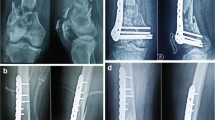Abstract
The sliding compression device, a widely used implant in unstable proximal femoral fractures, suffers from two major limitations: excessive collapse and screw cut-out. Commonly attributed reasons for these are lateral wall comminution and single-point fixation, respectively. We report our experience of stabilising 74 unstable trochanteric fractures, of which 46 cases underwent lateral wall reconstruction using a trochanteric stabilising plate (TSP) in combination with a dynamic hip screw (DHS), and 34 cases with an intact lateral wall had a DHS with an additional anti-rotation screw providing two-point fixation. Fracture consolidation was observed in all cases at an average of 13.56 weeks. Overall functional hip score as per the Salvati and Wilson scoring system was >30 points in 55 patients. Lateral wall reconstruction is an important component in stabilisation of unstable trochanteric fractures and a combination of TSP with a DHS appears to be a useful device to achieve this. Addition of an antirotation screw is likely to enhance the stability further by providing two-point fixation.
Résumé
Le matériel à compression est largement utilisé dans les fractures de l’extrémité supérieure du fémur avec deux limites, d’une part une impaction des fragments et, d’autre part, l’absence de fixité de la vis. Les raisons en sont l’importante communication du mur latéral avec un seul point de fixation. Nous rapportons notre expérience de la stabilisation de 74 fractures trochantériennes instables parmi lesquelles 46 ont bénéficié d’une reconstruction du mur latéral intact et en utilisant une plaque trochantérienne de stabilisation TSP combinée à la DHS et 34 cas présentant un mur latéral ayant bénéficié d’une DHS avec un système de vis anti rotation avec deux points de fixation. La consolidation de la fracture a toujours été observée avec une moyenne de 13,56 semaines. Cependant, le score fonctionnel de la hanche selon Salvati et Wilson était supérieur de 30 points chez 55 patients. La reconstruction du mur latéral est un élément important de la stabilisation des fractures trochantériennes instables. La combinaison d’une plaque TSP avec la vis DHS est un artifice utile pour améliorer cette stabilité. L’ajout d’une vis anti rotation est également profitable de façon à améliorer la stabilité du fait de deux points de fixation.



Similar content being viewed by others
References
Babst R, Renner N, Biedermann M, Rosso R, Hebere M, Harder F, Regazzoni P (1998) Clinical results using the trochanter stabilizing plate (TSP): the modular extension of the dynamic hip screw (DHS) for internal fixation of selected unstable intertrochanteric fractures. J Orthop Trauma 12:392–399
Davis TRC, Sher JL, Horsman A, Simpson M, Porter BB, Checketts RG (1990) Intertrochanteric femoral fractures: mechanical failure after internal fixation. J Bone Joint Surg 72B:26–31
Ecker ML, Joyce JJ, Kohl JE (1975) The treatment of trochanteric hip fractures using a compression screw. J Bone Joint Surg 87-A(1):23–27
Frohlich P, Benko T (1993) DHS (dynamic hip screw) osteosynthesis in the management of femoral fractures in the hip region and the place of this method in the treatment of such injuries. Magy Traumatol Ortop Kezseb Plasztikai Sch 36(1):59–64
Gadegone WM, Salphale YS (2007) Proximal femoral nail—an analysis of 100 cases of proximal femoral fractures with an average follow up of 1 year. Int Orthop 31(3):403–408
Gotfried Y (2004) The lateral trochanteric wall: a key element in the reconstruction of unstable pertrochanteric hip fractures. Clin Orthop Relat Res 425:82–86
Hardcastle P, Nade S (1985) The significance of the Trendelenburg test. J Bone Joint Surg 67-B:741–746
Hardy DC, Descamps PY, Krallis P, Fabeck L, Smets P, Bertens CL et al (1998) Use of an intramedullary hip screw compared with a compression hip screw with a plate for intertrochanteric femoral fractures: a prospective, randomized study of one hundred patients. J Bone Joint Surg Am 80(5):618–630
Jacobs RR, Armstrong JH, Whitaker JH, Pazell J (1976) Treatment of intertrochanteric hip fractures with a compression hip screw and a nail plate. J Trauma 16(8):599–602
Jones HW, Johnston P, Parker M (2006) Are short femoral nails superior to the sliding hip screw? A meta-analysis of 24 studies involving 3279 fractures. Int Orthop 30(2):69–78
Kyle RF, Gustilo RB, Premer RF (1979) Analysis of six-hundred and twenty-two intertrochanteric hip fractures. J Bone Joint Surg 61-A:216–221
Larsson S, Friberg S, Lars-Ingvar H (1990) Trochanteric fractures: influence of reduction and implant position on impaction and complications. Clin Orthop Relat Res 259:130–139
Lustenberger A, Ganz R (1995) Epidemiologie trochanterer femur fracturen uber 2 jahrzehnte (1972–1989). Unfallchirurg 98:278–282
Madsen JE, Naess L, Aune AK, Alho A, Ekeland A, Stromsoe K (1998) Dynamic hip screw with trochanteric stabilzing plate in the treatment of unstable proximal femoral fractures: a comparative study with the Gamma nail and compression hip screw. J Orthop Trauma 12(4):241–248
Parker MJ, Palmer CR (1993) A new mobility score for predicting mortality after hip fracture. J Bone Joint Surg 75-B:797–798
Rha JD, Kim YH, Yoon SI, Park TS, Lee MH (1993) Factors affecting sliding of the lag screw in intertrochanteric fractures. Int Orthop 17:320–324
Salvati EA, Wilson PD (1973) Long term results of femoral head replacement. J Bone Joint Surg Am 55A:516–524
Steinberg GC, Desai SS, Kornwitz NA, Sullivan TJ (1988) The intertrochanteric hip fracture. A retrospective analysis. Orthopaedics 11:265–273
Swiontkowski MF, Harrington RM, Keller TS (1987) Torsion and bending analysis of internal fixation techniques for femoral neck fractures: the role of implant design and bone density. J Orthop Res 5(3):433–444
Author information
Authors and Affiliations
Corresponding author
Rights and permissions
About this article
Cite this article
Gupta, R.K., Sangwan, K., Kamboj, P. et al. Unstable trochanteric fractures: the role of lateral wall reconstruction. International Orthopaedics (SICOT) 34, 125–129 (2010). https://doi.org/10.1007/s00264-009-0744-y
Received:
Revised:
Accepted:
Published:
Issue Date:
DOI: https://doi.org/10.1007/s00264-009-0744-y




